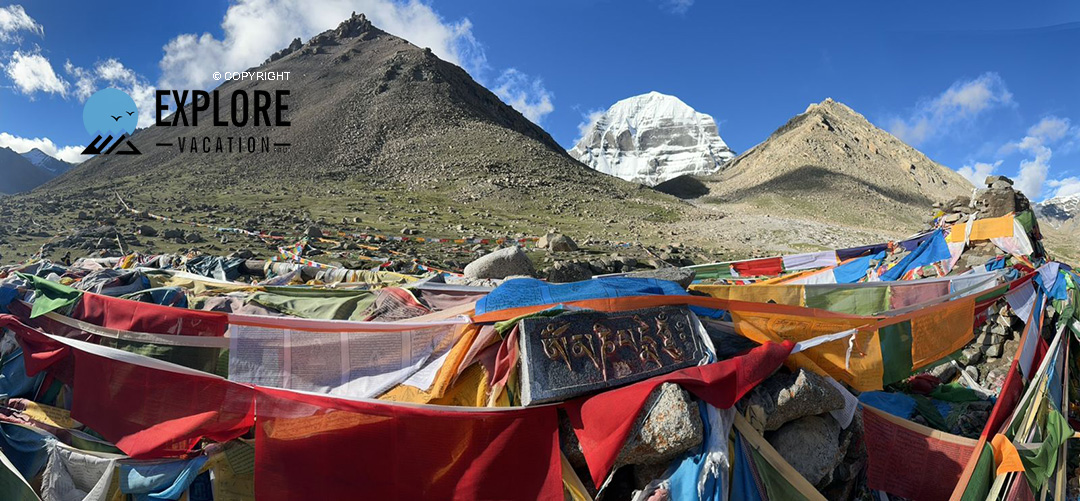Mount Kailash Value in Hindu Tradition
10 Sep, 2024 Explore Vacation

Mahabharata is one of the two major Smriti texts and Sanskrit epics of Hinduism. It narrates the events and aftermath of the Kurukshetra War, a war of bloodline between two groups of royal cousins, the Kaurava’s and Pandava’s from the Kuru kingdom, over the throne of Hastinapura. In the Mahabharata, Mount Kailash holds a special place as a sacred mountain, often associated with Lord Shiva. While the epic directly does not contain a story about Mount Kailash but frequently refers to Shiva and his divine connection to the mountain.
Pandava's Journey to Mount Kailash
The Kurukshetra war lasted 18 days. After the long war, the Pandeva’s, victorious but emotionally exhausted, began to search for relief and spiritual peace. Yudhishthira, the eldest of the Pandavas, felt the burden of war's devastation and looked for inner calm and divine guidance. Bhīma (second brother), Arjuna (third brother), Nakul (fourth brother), Sahadev (fifth brother), and Draupadi, wife of the five Pandava’s brothers, also known by the names Krishnā, Panchali, and Yajnaseni, longed for a retreat to find inner calm after the great disturbance.
One day Pach Pandeva’s decided to step aboard on a pilgrimage to visit the holiest places in the world. During their journey, they heard about Mount Kailash, the adobe of Lord Shiva’s majestic peak, high in the Himalayas, a place where mortals could connect with the divine, and those who visited often found their lives transformed.
Committed to experiencing this sacred place, the Pandavas set out on the long journey. The path to Mt. Kailash was hard and dangerous, with steep cliffs, freezing temperatures, and thin air that made breathing difficult. Yet the Pandavas were resolute. They believed that their faith and devotion would guide them through the hardships.
As they climbed higher, they encountered many sages and holy men who had come to the mountain to meditate. On the way they talked with sages, sages shared stories of Lord Shiva’s power and grace and how he danced the cosmic dance of creation and destruction (Tandava) at the top of Kailash, maintaining the balance of the universe. The faith in Lord Shiva grew stronger after hearing these stories.
After the long journey and dedication to Shiva, they finally reached the base (charan sparsha) of Adi Kailash. Looking at the snow-covered peak, Pandava’s felt a sense of relief and peace, so they started praying, mediating, and seeking blessings for inner peace and spiritual freedom.
It is believed that when they prayed at the base of Kailash Mountain, Lord Shiva appeared before them in his charitable form, Granting them with divine blessings. Shiva gave them the lesson that true peace could only be found within, through the practice of dharma and devotion. Each pandav was blessed, giving them the strength to continue their journey towards self-realization and guiding them on the path to wisdom.
As the Pandava’s return from Kailash with a new purpose of living. Though they had much suffering on the way and climate war, the blessing from Lord Shiva and the beauty of the mountain encouraged them a sense of clarity and peace. They realized that the divine presence was always inside them, guiding them through the trails of life.
Hence, the Pandeva’s journey to Mt. Meru became a spiritual symbol and connection to Lord Shiva. The holy mountain of Kailash continues to be revered as a place of divine energy, where those who seek the truth may find an answer within themselves.
Mount Kailash Value in Hindu Tradition
The Holy Kailash is considered the “Centre of the World” in Hinduism, Buddhism, and Jain. As the focus is more on Lord Shiva in the Mahabharata, the symbolic connection between the mountain and the god of destruction and transformation is clear. Shiva, who stayed on Mount Kailash with his wife Parvati, represents that truth and the cycle of life and death.
The Journey to Kailash is often seen as a truth-for-life journey—full of challenges but with the promise of spiritual fulfillment for those who have faith and devotion.
Travel Blog
-
 27 Apr, 2025
27 Apr, 2025 -
 20 Sep, 2024
20 Sep, 2024What is Indra Jatra and its importance in tourism in nepal
-
 29 May, 2022
29 May, 2022Nepal’s Tara Air flight, with four Indians onboard, crashes
-
 27 Feb, 2019
27 Feb, 2019Helicopter Crashed in Nepal
-
 16 Dec, 2018
16 Dec, 20185 Reasons Why Travelling To Nepal Will Change Your Life
-
 16 Dec, 2018
16 Dec, 2018Nepal Put On Top Of 10 Must-See Countries
-
 16 Dec, 2018
16 Dec, 2018Nepal Among Top 18 Destinations For 2016
-
 16 Dec, 2018
16 Dec, 2018Everest Mountaineers Mourn Avalanche Dead One Year On
-
 16 Dec, 2018
16 Dec, 2018Indian Pilgrims Died In Nepal Bus Plunge
-
 27 Feb, 2019
27 Feb, 2019Chopper Crashed in Taplejung, Nepal, Including Tourism & Civil Aviation Minister Rabindra Adhikari & six others death